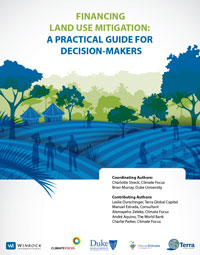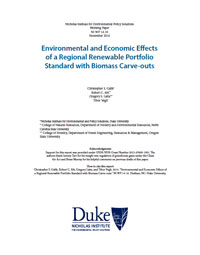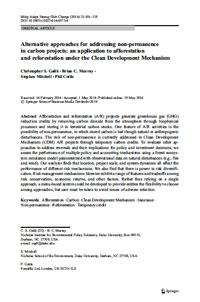Publications
Unbundling Water Rights: A Blueprint for Development of Robust Water Allocation Systems in the Western United States
This report lays out a blueprint for transitioning to robust water rights, allocation, and management systems in the western United States—a blueprint ready for pilot testing in Nevada’s Diamond Valley and Humboldt Basin. If implemented, the blueprint’s reforms would convert prior appropriation water rights into systems that keep water withdrawals within sustainable limits, allow rapid adjustment to changing water supply conditions, generate diverse income streams, and improve environmental outcomes. The blueprint’s essential element is unbundling of existing water rights. In law and economics, property rights are often described as a bundle of sticks. When applied to a water right, unbundling involves separating an existing right into its specific, component parts. In an unbundled system, each part is defined and can be managed and traded separately. During the unbundling process, as proposed here, the value of each component is enhanced, and the taking of property rights is avoided. Unbundling brings clarity to water rights and reveals the true value of the water, because willing buyers and sellers are able to trade with one another with dramatically reduced transaction costs. “Liquid markets” emerge. Shares, a primary product of the unbundling, can be used to finance innovation, and opportunities for improving environmental outcomes are increased through the transparent value of water rights shares and allocations. If water managers in Nevada find that an unbundled water rights system is more desirable than the current system, they can use this report’s proposed reforms and schedules to facilitate the transition to it. Although the state engineer and governor’s office may have sufficient perquisites to proceed without the support of new legislation, implementation would be easier if underpinned by legislation.
Financing Land Use Mitigation: A Practical Guide for Decision-Makers
This report, produced as part of a U.S. Department of State-funded project by Winrock International, serves as a practical guide for those seeking finance to implement specific actions to reduce emissions from land use. It is intended to assist national policy makers and other decision makers in accessing and leveraging financial mechanisms to support activities that reduce forest greenhouse gas emissions and increase forest carbon stocks. It features an in-depth exploration of efforts to raise finance for low-emission, sustainable land use activities in Mexico and Ethiopia—two countries with ambitious REDD+ and LED goals but with widely differing natural environments, macroeconomic conditions, and institutional experience. These conditions allow Mexico and Ethiopia to offer important lessons to other countries seeking to develop low-emission and sustainable land use strategies.
The Environmental and Economic Effects of Regional Bioenergy Policy in the Southeastern U.S.
The unique generation, landownership, and resource attributes of the southeastern United States make the region an important test bed for implementation of novel renewable energy policy interventions. This study evaluates the environmental and economic implications of one such intervention, a hypothetical region-wide renewable portfolio standard (RPS) with biomass carve-outs. It utilizes the Forest and Agriculture Sector Optimization Model with Greenhouse Gases (FASOMGHG) to assess the multi-sector and interregional allocation of forest harvest activity, and then uses the Sub-Regional Timber Supply (SRTS) model to assess intraregional variation in forest composition and greenhouse gas (GHG) mitigation potential. The analysis finds that existing resource conditions influence the regional distribution of land use and harvest changes, resulting in a spatially and temporally diverse forest carbon response. Net forest carbon in the Southeast is greater in the RPS Scenario than in the No RPS Scenario in all but the final years of the model run. Accounting for displaced fossil emissions yields net GHG reductions in all time periods. Both research methodology and findings are also applicable to a broader suite of domestic and international policies, including European Union renewable energy initiatives and GHG mitigation under Section 111 of the U.S. Clean Air Act.
Sustainability Guidelines and Forest market Response: An Assessment of European Union Pellet Demand in the Southeastern United States
Woody biomass from the southeast United States is expected to play an important role in meeting European Union (EU) renewable energy targets. In crafting policies to guide bioenergy development and in guiding investment decisions to meet established policy goals, a firm understanding of the interaction between policy targets and forest biomass markets is necessary, as is the effect that this interaction will have on environmental and economic objectives. This analysis, featured in the journal Global Change Biology-Bioenergy, increases understanding of these interactions by modeling the response of southern U.S. forest markets to new pellet demand in the presence of sustainability sourcing or harvest criteria. Based on modeled scenarios, it finds that wood pellets from the Southeast United States could be used to meet sustainability guidelines set by the EU to achieve its larger renewable energy and greenhouse gas emissions goals.
Environmental and Economic Implications of Regional Bioenergy Policy
The unique generation, landownership, and resource attributes of the southeastern United States make the region a ripe and important test bed for implementation of novel renewable energy policy. This policy brief describes the environmental and economic implications of one policy intervention: a hypothetical region-wide renewable portfolio standard (RPS) with separate biomass targets or “carve-outs.” A study of this intervention shows that over time the dominant contributor to such an RPS would be forest biomass and that existing resource conditions would influence patterns of biomass harvesting, resulting in a spatially and temporally diverse forest carbon response. Net forest carbon storage in the Southeast would be greater with the hypothetical RPS than without it in all but the final years of the modeled time period, but when displaced fossil fuel emissions are accounted for net greenhouse gas (GHG) reductions over the period could be substantial. The methods and findings presented here are also relevant to a broader array of policies that could increase biomass demand from the region, including pellet exports from the United States to the European Union and regulation of greenhouse gases under the Clean Air Act.
Effect of Policies on Pellet Production and Forests in the U.S. South: A Technical Document Supporting the Forest Service Update of the 2010 RPA Assessment
Current policies in the European Union (EU) requiring renewable and low greenhouse gas-emitting energy are affecting wood products manufacturing and forests in the United States. These policies have led to increased U.S. pellet production and export to the EU, which has in turn affected U.S. forests and other wood products manufacturing. At this time, the primary exporting region in the United States is the South, and the primary importing countries in the EU are the United Kingdom, Belgium, and the Netherlands. The policies and some Member State subsidies are expected to continue in place until at least 2020, with the potential to continue beyond that date. Key drivers of U.S. pellet feedstock supply include both the age structure of current timber inventory and the policies that define sustainability. Also influencing the effect of increased demand for timber for pellets are the price-inelastic supply and demand. A simulation of the market responses to increases in both pellet and other bioenergy demand in the U.S. South suggests that prices will increase for timber as harvest increases, and will in turn lead to long-term changes in inventory and forest land area.
Environmental and Economic Effects of a Regional Renewable Portfolio Standard with Biomass Carve-outs
The unique generation, landownership, and resource attributes of the southeastern United States make the region a ripe and important test bed for implementation of novel renewable energy policy interventions. This study evaluates the environmental and economic implications of one such intervention, a hypothetical region-wide renewable portfolio standard (RPS) with biomass carve-outs. It utilizes the Forest and Agriculture Sector Optimization Model with Greenhouse Gases (FASOMGHG) to assess the multi-sector and interregional allocation of increased harvest activity to meet the RPS. It then uses the Sub-Regional Timber Supply (SRTS) model to assess the intraregional allocation of harvests within the southeastern United States. The analysis finds that forest biomass is the dominant contributor to the regional RPS; national data suggest a substantial reallocation of harvests across both time and space. Existing resource conditions influence the regional distribution of land use and harvest changes, resulting in a spatially and temporally diverse forest carbon response. Net forest carbon in the Southeast is greater in the RPS Scenario than in the No RPS Scenario in all but the final years of the model run. Accounting for displaced fossil emissions yields substantial net greenhouse gas (GHG) reductions in all assessed time periods. Beyond the RPS, both research methodology and findings are applicable to a broader suite of domestic and international policies. A version of this paper was published in Energy Policy.
Why Water Markets Are Not Quick Fixes for Droughts in the Western United States
Because of the peculiar nature of water rights, we should look to market-based transactions as an economically efficient way to reallocate scarce water resources. Nevertheless, because of the need to untangle the hydrologic interconnectedness of water rights and the institutional connectedness of irrigators and delivery institutions in the West, transfers of water will always be expensive and time consuming. Whether municipalities purchase water from farmers and thus bear the transaction costs directly, or the private sector purchases agricultural water, bears the associated risk and transaction costs, and sells it on to municipalities, end users will inevitably pay higher prices for water. Droughts can focus public attention on the value of water and potentially increase willingness-to-pay prices that reflect the transaction costs of tangled western water markets.
Synthesis and Review: Advancing Agricultural Greenhouse Gas Quantification
Reducing emissions of agricultural greenhouse gases (GHGs), such as methane and nitrous oxide, and sequestering carbon in the soil or in living biomass can help reduce the impact of agriculture on climate change while imporving productivity. A new article in a special focus issue of Environmental Research Letters synthesizes the current findings on the state of the capacity for agricultural GHG quantification. It concludes that strategic investment in quantification can lead to significant global improvement in agricultural GHG estimation in the near term.
Alternative Approaches for Addressing Non-Permanence in Carbon Projects: An Application to Afforestation and Reforestation under the Clean Development Mechanism
Afforestation and reforestation (A/R) projects generate greenhouse gas reduction credits by removing carbon dioxide from the atmosphere through biophysical processes and storing it in terrestrial carbon stocks. One feature of A/R activities is the possibility of non-permanence, in which stored carbon is lost though natural or anthropogenic disturbances. The risk of non-permanence is currently addressed in Clean Development Mechanism (CDM) A/R projects through temporary carbon credits. To evaluate other approaches to address reversals and their implications for policy and investment decisions, the authors assess the performance of multiple policy and accounting mechanisms using a forest ecosystem simulation model parameterized with observational data on natural disturbances . The analysis, featured in the journal Mitigation and Adaptation Strategies for Global Change, finds that location, project scale, and system dynamics all affect the performance of different risk mechanisms. It also find that there is power in risk diversification. Risk management mechanisms likewise exhibit a range of features and tradeoffs among risk conservatism, economic returns, and other factors. Rather than relying on a single approach, a menu-based system could be developed to provide entities the flexibility to choose among approaches, but care must be taken to avoid issues of adverse selection.










